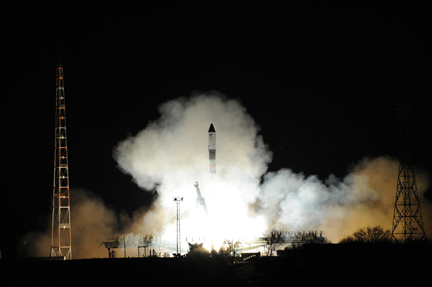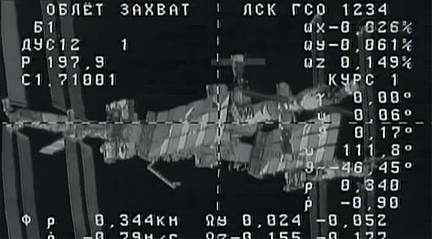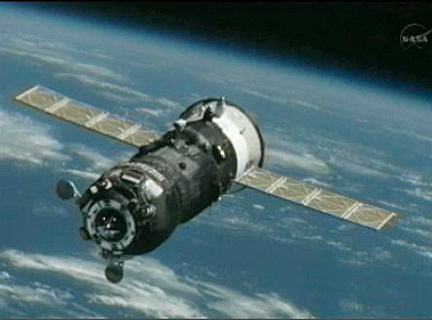Russian supply ship takes off on station resupply flight
Editor's note...
CBS News
An unmanned Russian Progress supply ship loaded with 2.9 tons of supplies and equipment blasted off Monday and rocketed into orbit, flying a fast-track trajectory to an automated docking with the International Space Station just six hours later.
The Progress M-18M spacecraft's Soyuz booster roared to life at 9:41:46 a.m. EST (GMT-5; 8:41 p.m. local time) and quickly climbed away from its launch pad through a cold, clear sky at the Baikonur Cosmodrome in Kazakhstan.
After a flawless climb to space, the supply ship was released into its planned preliminary orbit eight minutes and 45 seconds after liftoff. A few moments after that, the vessel's two solar arrays and navigation antennas deployed as planned.
The space station was just 870 miles downrange from the launch site at the moment of liftoff, giving the crew a ringside seat for the fiery nighttime climb to space.
"The cameras on the International Space Station (were) pointed ... to look at the launch as the station passed off to the northeast and in fact Kevin Ford, the commander of Expedition 34, did report he was able to see first stage separation, which occurred about two minutes after launch," said NASA commentator Kyle Herring.
Launched directly into the plane of the space station's orbit, the Progress M-18M completed an automated approach to the lab complex and after a final check to make sure all systems were operating normally, the cargo craft moved in for a picture-perfect docking at the Earth-facing Pirs compartment around 3:35 p.m., five hours and 55 minutes after liftoff.
"We have capture," a crewman radioed from the station as the docking system engaged.
"Congratulations on automatic docking," a Russian flight controller said a few moments later, speaking through a translator.
The Progress M-18M spacecraft is loaded with 1,764 pounds of space station propellant, 110 pounds of oxygen and air, 926 pounds of water and 3,000 pounds of spare parts, science gear and other dry cargo. It is scheduled to remain docked at the space station until late April.
Progress supply ships and manned Soyuz Spacecraft typically are launched on trajectories that require two days -- 34 orbits -- to reach the space station. But Russian flight controllers have been testing a single-day four-orbit rendezvous sequence on recent Progress flights and tentatively plan to implement the procedure for the next manned Soyuz flight in March.
From the crew's perspective, spending less time in the cramped confines of the Soyuz ferry craft is a clear positive. But it leaves little margin for error. The trajectory requires considerable planning due to the extreme precision required and additional time between launch attempts would be needed if bad weather triggered a delay or an unplanned space station maneuver was required.
Progress M-18M, the 50th Russian supply ship launched to the station, is the first of four Russian cargo ships scheduled for launch this year and the third to follow an abbreviated four-orbit rendezvous.
"A four-orbit rendezvous means you have to know precisely where ISS is within pretty tight tolerances at launch time," Mike Suffredini, NASA space station program manager, told reporters last month. "Because you don't really have time for the Soyuz to make up the phasing differences that are inherent in a system like ISS.
"You can do no burns on ISS on any given orbit and just because of the size and the nature of the ISS and the environment it flies in, (atmospheric) drag alone can vary enough that the ISS won't be where you expect it to be. Because you're talking about such tight tolerances, that can be significant."
As a result, space station maneuvers relatively close to launch can trigger launch delays and extensive replanning.
"If I do a debris avoidance maneuver (in January), I have to consider whether that impacts a flight in March," Suffredini said. "So you can see from an ops standpoint, it becomes much, much more difficult. ... That's turning out to be an enormous amount of work for the ops team.
"So that's part of what we have to work with our Russian colleagues, to talk about the gain from the savings of time getting to ISS quicker, does that offset the impacts we're going to have just flying the ISS day to day?"
He said space station managers have tentatively agreed to "do this once or twice to show we have the capability in case we need to get to ISS quick for any reason."
"But the decision to fly like this long term is still out there to be determined," he said.
- Posted at 10:11 AM EST, 02/11/13: Russian supply ship takes off on station resupply flight
- Updated at 03:45 PM EST, 02/11/13: Progress cargo ship docks with space station
CBS News
An unmanned Russian Progress supply ship loaded with 2.9 tons of supplies and equipment blasted off Monday and rocketed into orbit, flying a fast-track trajectory to an automated docking with the International Space Station just six hours later.
The Progress M-18M spacecraft's Soyuz booster roared to life at 9:41:46 a.m. EST (GMT-5; 8:41 p.m. local time) and quickly climbed away from its launch pad through a cold, clear sky at the Baikonur Cosmodrome in Kazakhstan.
 |
| The Progress M-18M supply ship blasts off from the Baikonur Cosmodrome in Kazakhstan, carrying 2.9 tons of supplies and equipment bound for the International Space Station. (Credit: RSC Energia) |
The space station was just 870 miles downrange from the launch site at the moment of liftoff, giving the crew a ringside seat for the fiery nighttime climb to space.
"The cameras on the International Space Station (were) pointed ... to look at the launch as the station passed off to the northeast and in fact Kevin Ford, the commander of Expedition 34, did report he was able to see first stage separation, which occurred about two minutes after launch," said NASA commentator Kyle Herring.
Launched directly into the plane of the space station's orbit, the Progress M-18M completed an automated approach to the lab complex and after a final check to make sure all systems were operating normally, the cargo craft moved in for a picture-perfect docking at the Earth-facing Pirs compartment around 3:35 p.m., five hours and 55 minutes after liftoff.
"We have capture," a crewman radioed from the station as the docking system engaged.
"Congratulations on automatic docking," a Russian flight controller said a few moments later, speaking through a translator.
The Progress M-18M spacecraft is loaded with 1,764 pounds of space station propellant, 110 pounds of oxygen and air, 926 pounds of water and 3,000 pounds of spare parts, science gear and other dry cargo. It is scheduled to remain docked at the space station until late April.
Progress supply ships and manned Soyuz Spacecraft typically are launched on trajectories that require two days -- 34 orbits -- to reach the space station. But Russian flight controllers have been testing a single-day four-orbit rendezvous sequence on recent Progress flights and tentatively plan to implement the procedure for the next manned Soyuz flight in March.
 |
| The view from the Progress M-18M supply ship during final approach to the International Space Station... (Credit: NASA TV) |
 |
| ...and the view from the space station showing the approaching Progress. (Credit: NASA TV) |
"A four-orbit rendezvous means you have to know precisely where ISS is within pretty tight tolerances at launch time," Mike Suffredini, NASA space station program manager, told reporters last month. "Because you don't really have time for the Soyuz to make up the phasing differences that are inherent in a system like ISS.
"You can do no burns on ISS on any given orbit and just because of the size and the nature of the ISS and the environment it flies in, (atmospheric) drag alone can vary enough that the ISS won't be where you expect it to be. Because you're talking about such tight tolerances, that can be significant."
As a result, space station maneuvers relatively close to launch can trigger launch delays and extensive replanning.
"If I do a debris avoidance maneuver (in January), I have to consider whether that impacts a flight in March," Suffredini said. "So you can see from an ops standpoint, it becomes much, much more difficult. ... That's turning out to be an enormous amount of work for the ops team.
"So that's part of what we have to work with our Russian colleagues, to talk about the gain from the savings of time getting to ISS quicker, does that offset the impacts we're going to have just flying the ISS day to day?"
He said space station managers have tentatively agreed to "do this once or twice to show we have the capability in case we need to get to ISS quick for any reason."
"But the decision to fly like this long term is still out there to be determined," he said.